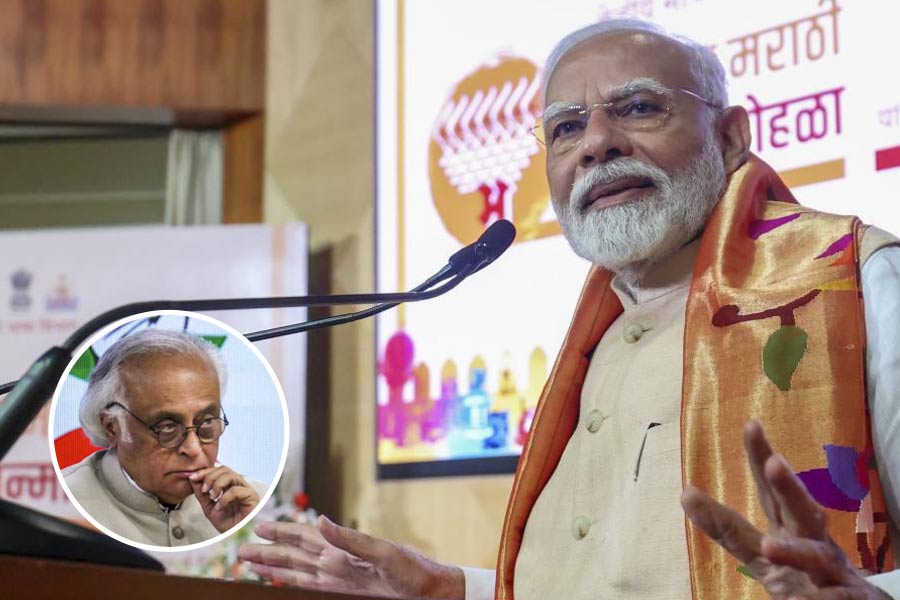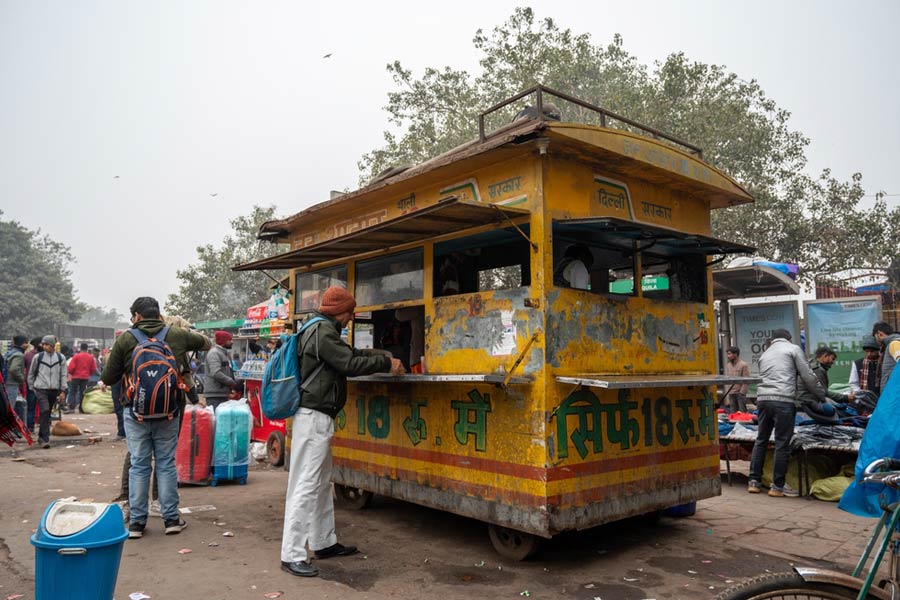
(below) panels reflecting the changing times


One of the kanthas made by Mahamaya Sikdar shows a woman talking into a mobile phone. Yes, unmistakably so. From a distance it looks like just another pretty pattern woven in red, brown and black threads, but if you look carefully it depicts a variety of scenes from urban as well as rural life. Someone at the computer, someone else climbing a date palm tree, crooners nattily dressed.
In kantha lingo, Sikdar's creation would be described as a nakshi kantha.
The term " kantha" is used at its essential best to connote a humble quilt made of discarded or well-worn saris. The other usage is more synechdochian, and is a reference to a particular kind of needlework. Traditionally, both belonged together. But for a while now, the stitch has been reclaimed by high fashion, leaving the cloth bereft and lacklustre.
"The embroidery on the kantha elevated its status," says Nilanjana Ghose, daughter of legendary kantha artist Sreelata Sarkar.
Today, Ghose herself promotes this art form and employs 30 women who do kantha work, which she then retails. She tells us how the kantha stitch is not only the staid run, as many believe. "Rural women used back stitch, cross-stitch, satin stitch, the herringbone, and every other stitch that they knew to decorate the quilt. The ripples created by closely-knit linear run stitches added to the texture of the fabric. They at once decorated and also held the cloth together."
Kantha expert and associate professor of History at Howrah's Bijoy Krishna Girls' College, Rituparna Basu, says many kanthas came with nakshas or motifs embroidered on them. Women in the 19th century embroidered motifs from what was known as brata art, a ritual art form like the alpana. The motifs ranged from simple geometric designs to animal shapes - fish or birds - to representations of objects such as jewellery, mirrors and combs. Folklore mixed with stitches. Women started to sew motifs they thought spelt good fortune such as sheaves of corn, betel nuts, ponds teeming with fish. In that sense, every kantha was a nakshi kantha.
The exact nomenclature though, owes itself to the pen and not the needle.

In 1929, the Bengali poet, Jasimuddin Khan, wrote Nakshi Kanthar Math, a dramatised verse about a couple, Rupai and Saju. Rupai falls in love with Saju and the two get married. But there is no happily ever after for them. Following a quarrel with peasants of the neighbouring village, Rupai flees and Saju is left behind. She waits for him long years and whiles away her time embroidering her life's tragedies and banalities on a kantha. And as she lies on her deathbed she pleads with her mother: Ektu amare dhar dekhi ma such suta da o hate/Sesh chhabikhana enke dekhi jadi kono sukh hoi taate... Hold me up a little, mother, and give me a thread and needle/Let me paint the last picture and see if that helps me feel better a little.
Says Ghose, "Artists depicted things they saw and things they knew - sceneries, episodes from the Ramayana and the Mahabharata, parables. And all these embroidered quilts came to be known as nakshi kantha."
The earliest known existence of the kantha dates back 5,000 years, Basu quotes civil servant and folk art patron Gurusaday Dutt as having said once. Dutt's kantha collection is on display at the museum named after him in southwest Calcutta's Joka. Basu, who has done extensive research on the subject, says, Dutt's collection mirrors the march of the years. It has kanthas with pre-Aryan motifs such as the "asha danda", a double axe; the " khunti", which is the precursor of the trident, and is visible in Mohenjodaro art. It has kanthas from medieval Bengal, so identifiable owing to the motifs such as that of the Hindu deity, Lakshmi, as she appears in the pages of the Mangal-kavya, Hindu religious texts composed less between the 13th and 18th century.
Some of the recurring motifs of later times are peacock, parrot, owl, elephant, lion, tiger, horse and snake. These are not representative of the vagaries of the mind but are in fact, earliest types of geo-tagging. How so? Explains Basu, "The peacock and elephant indicate present-day Bengal, Bihar, Odisha, Chhattisgarh; the tiger, the Sunderbans; and the snake, north Bengal and parts of the Sunderbans." Motifs of fairies, clocks and hospitals spoke of colonial influences.
A 19th century kantha from the K.K. Birla collection, which can be found at the Birla Academy of Fine Arts in south Calcutta, works like a social critique. It depicts the beheading of Elokeshi, a 16-year-old who was beheaded by her husband, who suspected her of having had a dalliance with the Mahanta or priest of Tarakeswar.
There were others that had poignant messages embroidered on them - a wife's vow to obey her husband, a daughter remembering a departed parent, a mother grieving a beloved child, moral lessons, adages, and so on. Oftentimes, the threads were from the borders of the saris.
With the advent of the 20th century and the Swadeshi movement gaining momentum, the motifs changed. "From the invocation of the personal and the familial, motifs now appealed to a sense of community," says Basu. Another thing happened around then. The Bengali middle-class intellectual started to valorise the folk arts, which came to epitomise the image of golden Bengal. "It was a memory of the past and also the hope for a future they aspired to," she adds.
In 1920 at Kala Bhavan, the art school in Visva-Bharati, Santiniketan, a widowed woman from East Bengal was brought in by Rabindranath Tagore to give lessons in kantha art.
With the famine of 1943 and the Partition thereafter, the kantha became a powerful instrument of refugee rehabilitation. According to Nilanjana Ghose, a lot of women from educated Bengali families encouraged the homeless migrant women from East Bengal to pick up the needle. By association, the nakshi kantha got a boost. The motifs now mirrored the freedom struggle.
Kantha entered the lexicon of free India, especially urban India, in the 1970s and one of the pioneering figures was Sreelata Sarkar. Says Ghose, "Because kantha was traditionally done on used saris or sheets, a section of people might have looked down on it. My mother used the kantha stitch on new and more expensive cloth. She tried it on tussar and Bangalore silk. She also innovated with the product range."
Earlier, kantha was used to swaddle the newborn, serve as a quilt, and mothers would also include the intricately done nakshi kantha in the trousseau. In its new avatar, the kantha appeared as tea-cosies, handkerchiefs, jackets, mufflers.
Sarkar's themes were drawn from anything that ever touched her. Ghose shows us one of her mother's kanthas with a hunting scene on it, inspired by a Jaipuri painting; another one depicts a typical Bengali wedding, palanquin and all; yet another one shows a mother nursing a child.
Basu talks about the contributions of kantha revivalist Shamlu Dudeja and Ruby Pal Chaudhury of the Crafts Council of West Bengal in preserving, promoting and popularising the nakshi kantha. Ghose herself has incorporated world imagery into this art form - the birds of Japan, the bluebells of Italy.
We wander into a kantha exhibition at the Birla Academy of Fine Arts sometime in May. A group of women are sitting together - some employed with the Crafts Council, some students - working in silence, their needles diving in and out of cloth. Among them is Bina Dey, who received the President's Award for her work in 2014. She is not very keen to talk about her achievements, besides there is that betel nut that she is chewing on. The youngest of the lot is 22-year-old Manabi Das. We ask her about the earnings. "Earnings," she repeats, as if aghast. Then adds, "I do this for the love of it. My grandmother taught me."
And so the nakshi kantha lives on.










